
Aerospace and defense company Curtiss-Wright (NYSE: CW) reported Q4 CY2024 results exceeding the market’s revenue expectations, with sales up 4.9% year on year to $824.3 million. The company’s full-year revenue guidance of $3.36 billion at the midpoint came in 1.7% above analysts’ estimates. Its GAAP profit of $3.09 per share was 2.6% above analysts’ consensus estimates.
Is now the time to buy Curtiss-Wright? Find out by accessing our full research report, it’s free.
Curtiss-Wright (CW) Q4 CY2024 Highlights:
- Revenue: $824.3 million vs analyst estimates of $778.2 million (4.9% year-on-year growth, 5.9% beat)
- EPS (GAAP): $3.09 vs analyst estimates of $3.01 (2.6% beat)
- Management’s revenue guidance for the upcoming financial year 2025 is $3.36 billion at the midpoint, beating analyst estimates by 1.7% and implying 7.7% growth (vs 9.9% in FY2024)
- EPS (GAAP) guidance for the upcoming financial year 2025 is $12.25 at the midpoint, beating analyst estimates by 5.5%
- Operating Margin: 18.8%, down from 20.4% in the same quarter last year
- Free Cash Flow Margin: 33.7%, similar to the same quarter last year
- Market Capitalization: $13.31 billion
"Curtiss-Wright concluded the year with a strong, fourth quarter financial performance that reflected better-than-expected sales growth, record quarterly Adjusted diluted EPS of $3.27, strong free cash flow and robust order activity," said Lynn M. Bamford, Chair and CEO of Curtiss-Wright Corporation.
Company Overview
Formed from a merger of 12 companies, Curtiss-Wright (NYSE: CW) provides a range of products and services to the aerospace, industrial, electronic, and maritime industries.
Aerospace
Aerospace companies often possess technical expertise and have made significant capital investments to produce complex products. It is an industry where innovation is important, and lately, emissions and automation are in focus, so companies that boast advances in these areas can take market share. On the other hand, demand for aerospace products can ebb and flow with economic cycles and geopolitical tensions, which can be particularly painful for companies with high fixed costs.
Sales Growth
A company’s long-term performance is an indicator of its overall quality. While any business can experience short-term success, top-performing ones enjoy sustained growth for years. Regrettably, Curtiss-Wright’s sales grew at a tepid 4.6% compounded annual growth rate over the last five years. This fell short of our benchmark for the industrials sector, but there are still things to like about Curtiss-Wright.
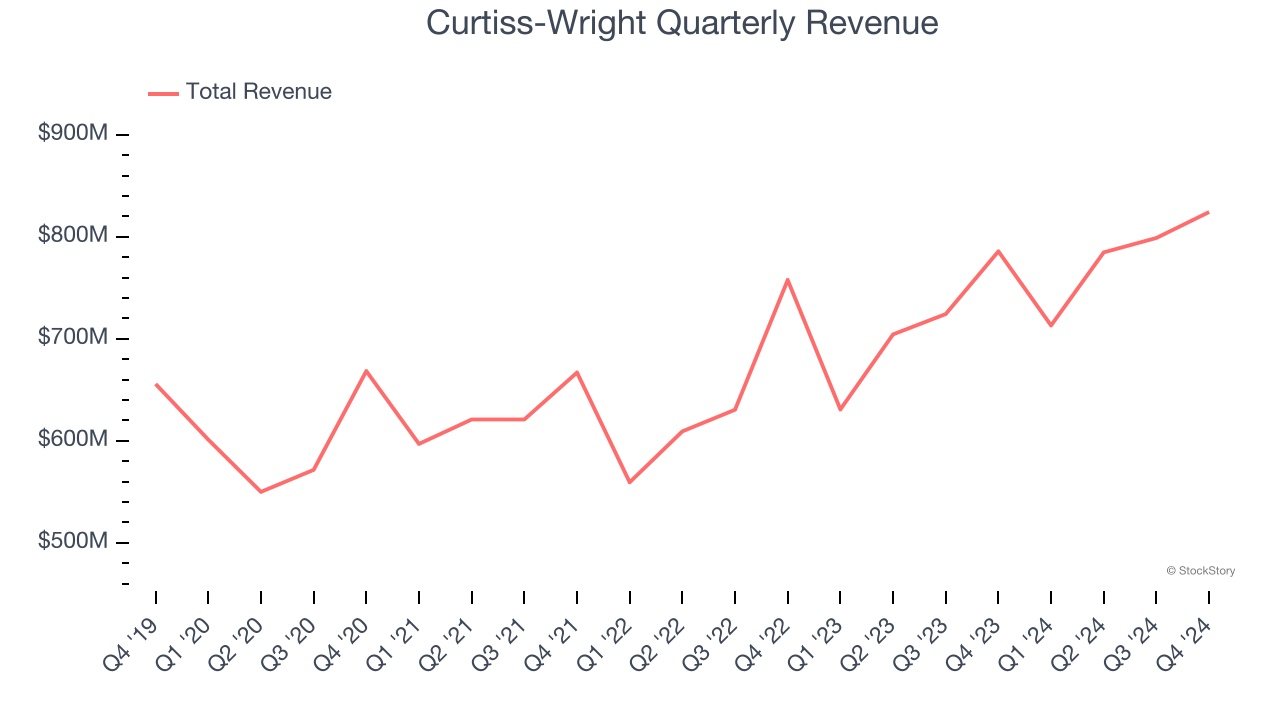
We at StockStory place the most emphasis on long-term growth, but within industrials, a half-decade historical view may miss cycles, industry trends, or a company capitalizing on catalysts such as a new contract win or a successful product line. Curtiss-Wright’s annualized revenue growth of 10.5% over the last two years is above its five-year trend, suggesting its demand recently accelerated. 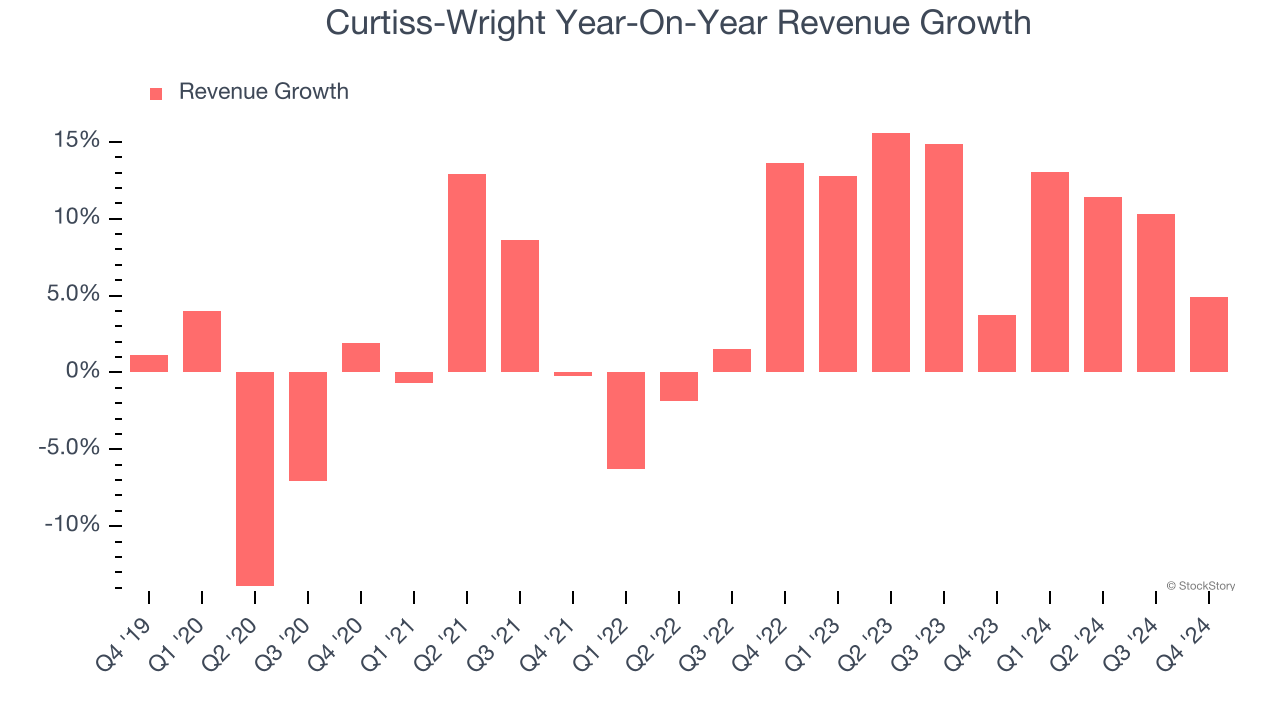
Curtiss-Wright also breaks out the revenue for its most important segments, Product and Services, which are 84.8% and 15.2% of revenue. Over the last two years, Curtiss-Wright’s Product revenue (aerospace & defense technology) averaged 11.6% year-on-year growth while its Services revenue (testing, maintenance, consulting) averaged 7% growth.
This quarter, Curtiss-Wright reported modest year-on-year revenue growth of 4.9% but beat Wall Street’s estimates by 5.9%.
Looking ahead, sell-side analysts expect revenue to grow 3.4% over the next 12 months, a deceleration versus the last two years. This projection is underwhelming and implies its products and services will see some demand headwinds. At least the company is tracking well in other measures of financial health.
Here at StockStory, we certainly understand the potential of thematic investing. Diverse winners from Microsoft (MSFT) to Alphabet (GOOG), Coca-Cola (KO) to Monster Beverage (MNST) could all have been identified as promising growth stories with a megatrend driving the growth. So, in that spirit, we’ve identified a relatively under-the-radar profitable growth stock benefiting from the rise of AI, available to you FREE via this link.
Operating Margin
Curtiss-Wright has been a well-oiled machine over the last five years. It demonstrated elite profitability for an industrials business, boasting an average operating margin of 15.7%.
Looking at the trend in its profitability, Curtiss-Wright’s operating margin rose by 4.9 percentage points over the last five years, showing its efficiency has improved.
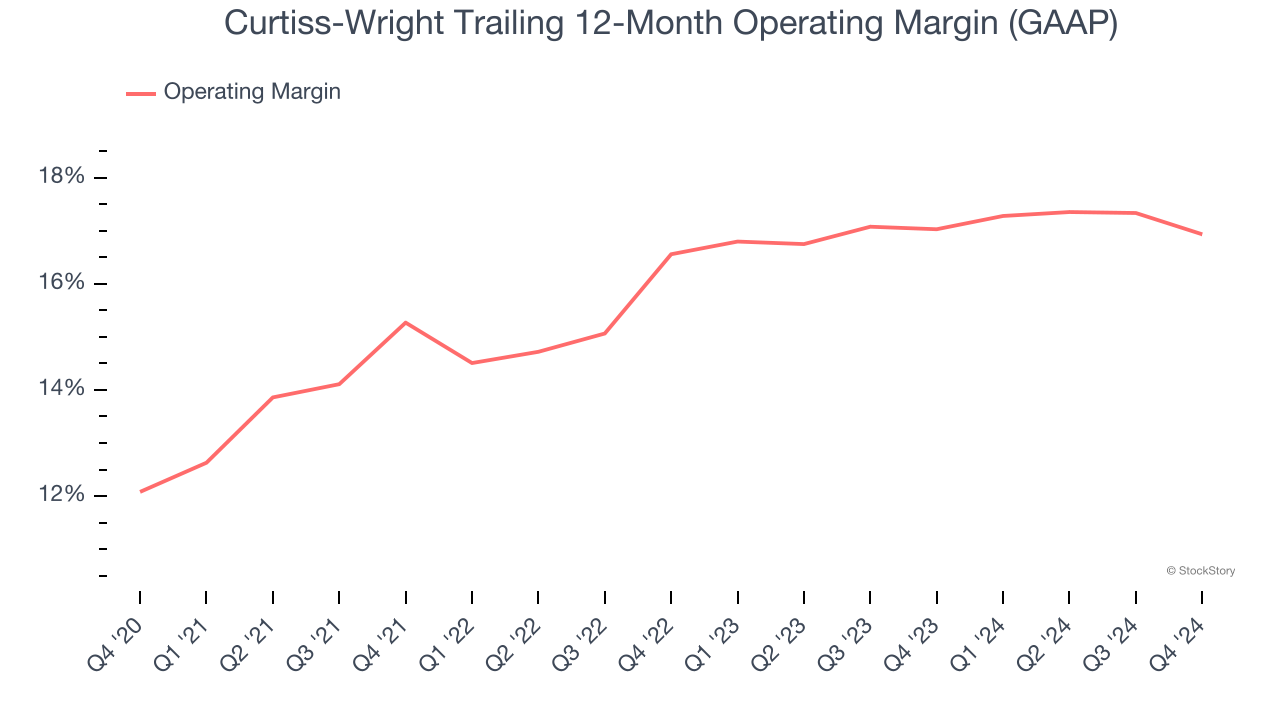
In Q4, Curtiss-Wright generated an operating profit margin of 18.8%, down 1.7 percentage points year on year. This reduction is quite minuscule and indicates the company’s overall cost structure has been relatively stable.
Earnings Per Share
Revenue trends explain a company’s historical growth, but the long-term change in earnings per share (EPS) points to the profitability of that growth – for example, a company could inflate its sales through excessive spending on advertising and promotions.
Curtiss-Wright’s EPS grew at a decent 8.1% compounded annual growth rate over the last five years, higher than its 4.6% annualized revenue growth. This tells us the company became more profitable on a per-share basis as it expanded.
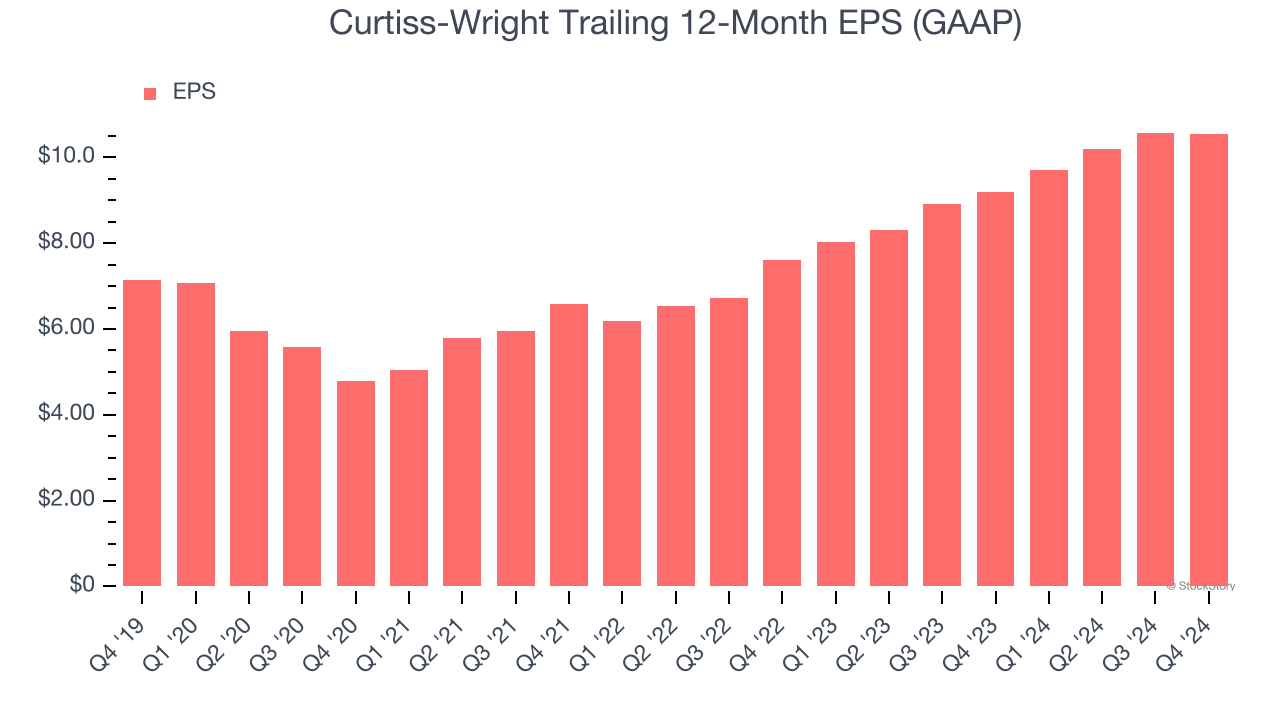
We can take a deeper look into Curtiss-Wright’s earnings to better understand the drivers of its performance. As we mentioned earlier, Curtiss-Wright’s operating margin declined this quarter but expanded by 4.9 percentage points over the last five years. Its share count also shrank by 11.3%, and these factors together are positive signs for shareholders because improving profitability and share buybacks turbocharge EPS growth relative to revenue growth. 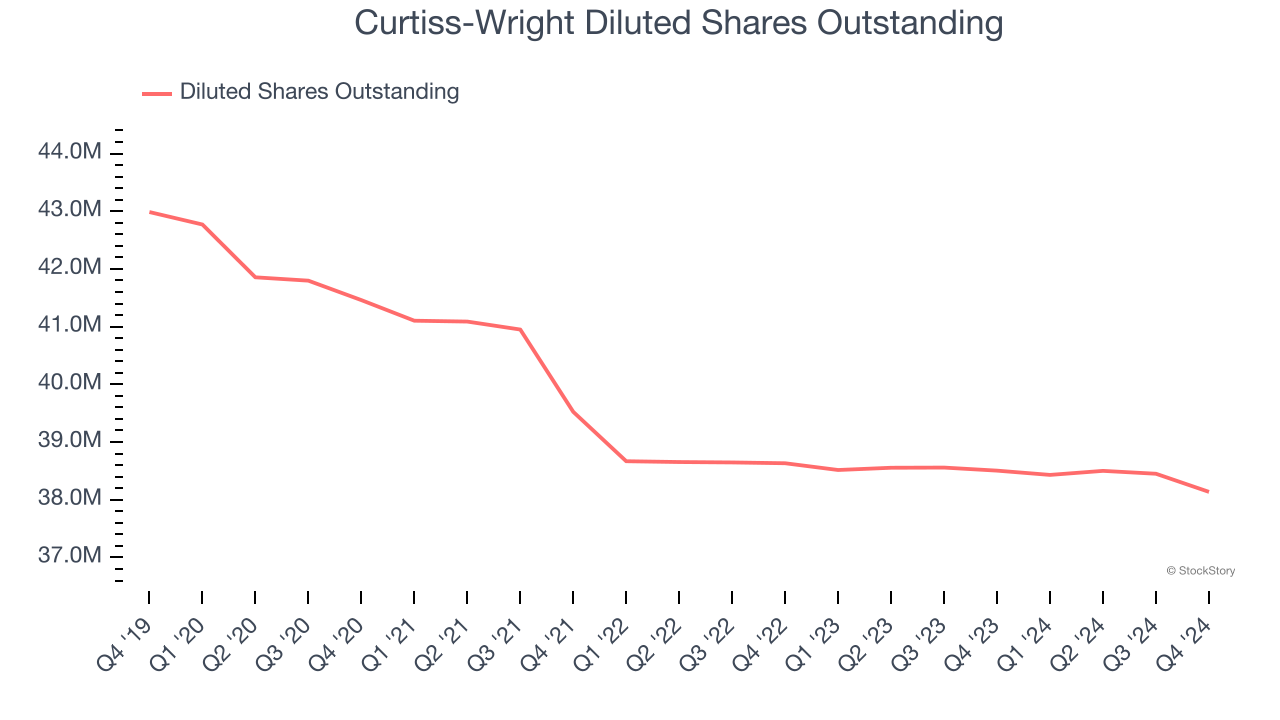
Like with revenue, we analyze EPS over a shorter period to see if we are missing a change in the business.
For Curtiss-Wright, its two-year annual EPS growth of 17.7% was higher than its five-year trend. This acceleration made it one of the faster-growing industrials companies in recent history.
In Q4, Curtiss-Wright reported EPS at $3.09, down from $3.11 in the same quarter last year. Despite falling year on year, this print beat analysts’ estimates by 2.6%. Over the next 12 months, Wall Street expects Curtiss-Wright’s full-year EPS of $10.55 to grow 11.9%.
Key Takeaways from Curtiss-Wright’s Q4 Results
We were impressed by how significantly Curtiss-Wright blew past analysts’ revenue and EPS expectations this quarter. We were also glad its full-year guidance for both metrics was higher than Wall Street’s estimates. Zooming out, we think this quarter featured some important positives. The stock traded up 9.5% to $374 immediately after reporting.
Curtiss-Wright may have had a good quarter, but does that mean you should invest right now? What happened in the latest quarter matters, but not as much as longer-term business quality and valuation, when deciding whether to invest in this stock. We cover that in our actionable full research report which you can read here, it’s free.







